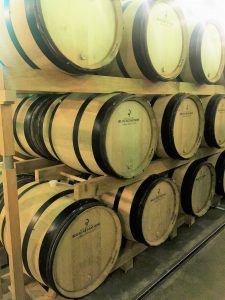So we’re kicking off with one of those fancy words but this is important because right now, the grape juice is still G-rated and non-alcoholic.
And we want to make it boozy! So what happens in first fermentation (and we get a little science-nerdy here) is we add yeast to the juice to set off a reaction that converts the sugar from the grapes into alcohol.
Then we ferment the juice for between one and four weeks (usually an average of two weeks) at a constant temperature of 16-20 degrees. And viola! Our grape juice has become alcoholic (maximum 11% alcohol) still wine (no bubbles yet!).
Champagne’s first fermentation is mostly done in steel vats (pictured at top) but you can also ferment in oak barrels (pictured left). Krug and Bollinger quite famously ferment in oak for all of the their wines. Billecart Salmon ferments in oak for some of their wines and several other houses selectively do oak fermentation.
But who cares if it’s oak or steel? I do! And you might too if you like oak-ey champagnes. The oak adds (not surprisingly) an oak flavour to the wine. Which is a bit controversial in champagne with houses divided over whether they think its a good thing that oak flavours add interest and flavour to the wine. There are those who believe the wines should be “pure” and the grapes should speak for themselves. Me… I love oak-ey champs. I think it adds diversity and choice, depending on the occasion and the food, which is always good.
Malolactic Fermentation (MLF)
OK… back to the story. So after the first fermentation, most champagne makers now choose to do a malolactic fermentation (MLF) before bottling… but it is not required. So not everyone does it… and not everyone does it all the time. What MLF does is it converts malic acid to a softer lactic acid.
What MLF means is a softer, smoother, less acidic taste – malic acid is quite tart-tasting but lactic acid is softer. The process should soften the wines and make them more approachable without taking away from the freshness or liveliness of the wines. A few houses who have steadfastly NOT performed MLF (such as Lanson and Louis Roederer) have started to allow it for the good of the wine.
Clarification
Finally, the wines which are still “still wines” are clarified to remove any residue. They’re then set aside in vats and stored at 10 degrees Celsius until blending. Blending may not occur until the start of the following year. Remember, harvesting usually occurs in September, followed immediately by pressing and then first fermentation which takes 2-4 weeks.
Blending or assemblage
Blending is possibly the greatest expression of art in champagne, with the house Chef de Cave as the ultimate artist.
The Chef de Cave of the house blends different grape varieties from different vineyards (and from different vintages for NV champagnes) to create the champagne. The NV champagnes, which are the signature house style, must taste the same every year. To achieve this consistency is such an incredible skill because each year’s harvest is influenced by the weather from that season and can produce incredibly different grapes or sometimes an under-supply of a particular kind of grape.
In contrast, vintage wines will change more from year to year as grapes from only that year can be used, but of course grapes from different crus can still be blended.
For example in blending at Mumm, about 2,000 samples are tasted, noted and memorised every year by Chef de Cave Didier Mariotti and his team. Up to 77 different crus will be used in the Cordon Rouge blend each year.
Cold stabilisation
After blending, your champs may undergo cold stabilisation before bottling. What this does is induce crystallisation of tartaric acid. What this means is it helps prevent crystal formation in the champagne during maturing. The wine is held at a very low temperature (-4°C) for at least a week or longer and clarified again to ensure the wine is perfectly clear for bottling.
Liqueur de tirage
And finally…. the very last thing to happen before champagne is bottled and sent to the cellars is one of the most important steps…. the step which gives champagne its bubbles.
This involves adding the liqueur de tirage which is made up of yeasts and 20-24 grams/litre of sugar. During secondary fermentation, the yeast consumes the sugar, creating alcohol and carbon dioxide… which produces the famous bubbles in champagne!
Coming up…
Part II has marked an important milestone in champagne’s transformation…. we watched the juice become booze and saw it take its final breath of fresh air before it is plunged into its bottle and sent to the cellar for its ultimate metamorphosis in the gripping finale in Part III!













